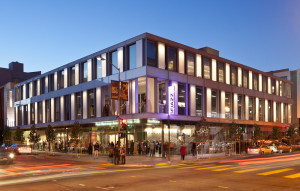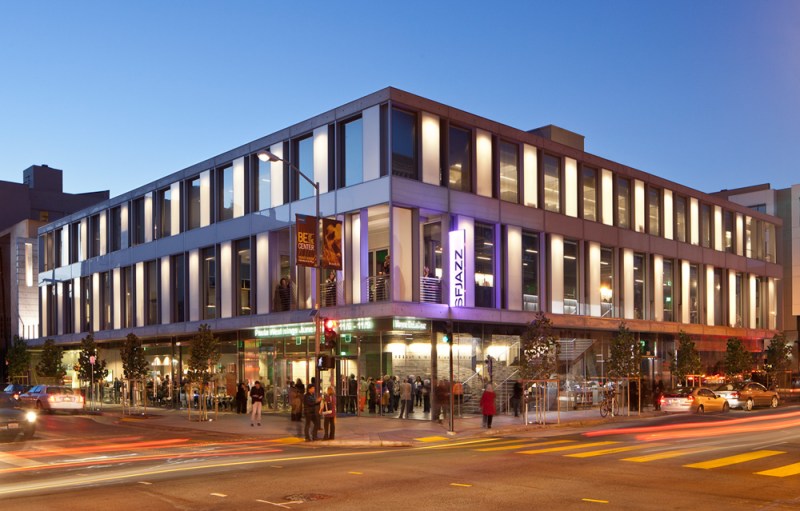
With an expected sense of decorum, visitors took their seats in the SFJAZZ Center’s Miner Auditorium, and quietly prepared for an evening of Latin jazz. As the lights dimmed, I felt the mood of the room change. Suddenly, performer John Santos was on stage, engaging us, the audience, in casual repartee. Instead of providing a formal context for the performance, Santos informally talked about his love for Latin jazz, and joked with the audience about buying his new CD.
It was this casual atmosphere that immediately set the space apart from other theaters I had visited previously.
“We wanted a space that had the intimacy of a jazz club, but had all the functions of a major performing arts center,” affirmed Executive Director of SFJAZZ Randall Kline.
Even upon entering the SFJAZZ Center, you see a balance between the grandeur of a theater and a more relaxed, social atmosphere. Though many glass buildings have an austere presence, the SFJAZZ Center gives off an inviting vibe, drawing the average passerby inside. According to Kline, the use of glass in the facade was instrumental, as “we wanted to increase the accessibility to the music while lowering the intimidation people might have to the music.”
At the same time, the exterior has a theatrical presence. Like many Broadway theaters, the SFJAZZ Center lights up at night, setting it apart from neighboring restaurants, residences and businesses.
Concrete floors and simple modern design define the lobby area and staircase up to the Miner Auditorium. However, inside the auditorium, the slatted wood paneling covering most of the walls establishes a new sense of warmth and intimacy. According to the theater’s acoustician Sam Berkow, the design of this auditorium corresponds with the “great desire to make the entire audience feel as unified as possible.” With seating on all four sides of the stage, members of the audience can see both the performers and each other throughout the night. It almost felt like I was in the smaller, more intimate venue of a jazz club.
The main auditorium’s asymmetrical design is both aesthetically pleasing and technically ingenious. Berkow commented, the “asymmetry reduces the geometric complexity of the room, which is useful in trying to achieve a uniform sound for the audience.” Berkow explained that he aimed to create a sense of tonal balance in each performance room
A large canopy of wooden acoustical is perched above the stage to scatter sound across the room. Provisions had to be made for this room to remain acoustically isolated, so as to not interrupt performances in neighboring auditoriums. According to Berkow, this issue was resolved through “box in box construction,” prohibiting any sound transfer through services like ducts or pipes.
“We were inspired by Boston’s Old South Meeting Hall as well as Unitarian churches designed by Frank Lloyd Wright and Louis Kahn,” stated Kline. Even though it was built in the past year, the SFJAZZ Center echoes these buildings’ preoccupation with space, acoustics and the fostering of community.
Only a year past its final stage of construction, the SFJAZZ Centre has sent ripples through the Bay Area community with the bold aesthetics and acoustics of its design, just as it sends sonic ripples of jazz through its auditoriums every week. The center now serves as the long overdue, centralized home of jazz music in San Francisco. With a home base, SFJAZZ has been able to better infiltrate the community by more frequently offering shows. With this increase has come a spike in annual membership. Today, the modern SFJAZZ Center stands as a symbol both of jazz in San Francisco, and of jazz as a modern, international art.
Contact Mary Carole Overholt at mco95 “at” stanford.edu.
